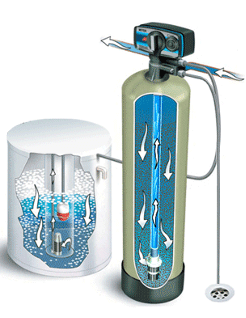Living in a home with hard water can become a costly problem. When water flows through the pipes of your home, the dissolved minerals combine with heat, leaving scale and buildup that damages your pipes, appliances, and fixtures.
Mineral buildup can cause a wide range of damage over a short amount of time. It will cling to the lining of pipes and decrease water pressure. Also, it will cause nasty water ‘spots’ on your glass wear, fixtures, and countertop are not only annoying but require your time continually wiping them off.
Mineral buildup is not exclusive to pipes. Your appliances that use water are also at risk of suffering breakages due to mineral buildup. Dishwashers, refrigerators, washing machines and water heaters commonly have repairs due to mineral buildup on critical components of these appliances.
Now let’s talk about the effects of hard water on your clothing, skin, and hair. If the clothing you just washed is dingy, or the colors faded, hard water could be to blame. Itchy, dry, and flaky skin or hair could also result from bathing with hard water.
So now that we know the effects of hard water on the body and home, how can we fix it?
A water softener is the most affordable means to “soften” your hard water. A water softener works by removing the magnesium and calcium present in your water through a process of ion exchange, turning it from hard water to softened water. So, what’s an ion exchange? The water softener unit contains several feet of porous plastic resin beads covered with molecules that attract and bind to positive ions in the water. Because magnesium and calcium are both positively charged, they stick to the resin and go through the ‘regeneration process’ of the softener. By adding salt to the softener, a solution of salt-water (brine) flows through the resin tank, rinsing the resin and attached magnesium and calcium and then exchanging new sodium for the hard water minerals collected. This is known as the water softener backwash cycle. The brine solution and hard water minerals are flushed from the tank into a nearby drain. The resin beads are then renewed and ready to collect hard water minerals again.

A common question asked is if water softeners remove iron from my water? Water softeners remove ferrous iron (dissolved iron) in low quantities. Ferric iron (insoluble iron) is more difficult to remove with a softener. Large amounts of ferric iron can cause your resin beads to work harder, and additional chemical solutions may be needed to prolong your resin bead’s life. Iron is best removed from water by an iron filter or a more comprehensive filtration system like reverse osmosis.
By adding sodium to my water, is soft water safe to drink? Yes, soft water is safe to drink. During the ion exchange process, the resin beads release sodium into the water when grabbing ahold of the hardness minerals, but the sodium in softened water isn’t unhealthy and is far less than what is widely imagined.
As technology improves, so do water treatment solutions. So, if you are having trouble determining whether to install a water softener or reverse osmosis system, here are some simple facts that may assist. Reverse osmosis (RO) systems purify your water, and water softeners reduce hardness in your water. RO systems use a semi-permeable membrane to filter your water, reducing nearly all contaminants and minerals that are flushed down the drain, leaving you with clear water. The process of RO reduces salt, minerals, and any other impurities. Water softeners use ion exchange to replace minerals that cause your water to be hard with sodium or potassium, making your water soft. RO systems are less efficient than water softeners for a whole-home solution; therefore, they are usually installed at a single point-of-use, like the kitchen sink.
A water softener will protect the reverse osmosis membrane and make it last longer. The water softener will soften water throughout your home, providing benefits for your pipes, appliances, fixtures skin, and hair. The reverse osmosis system can be installed under a sink to provide purified water at a separate tap for drinking and cooking. Some customers choose to use both methods.
So, if you are trying to determine your specific needs, Anthony PHCE plumbers can assist with helping you choose the best solution for your home.
